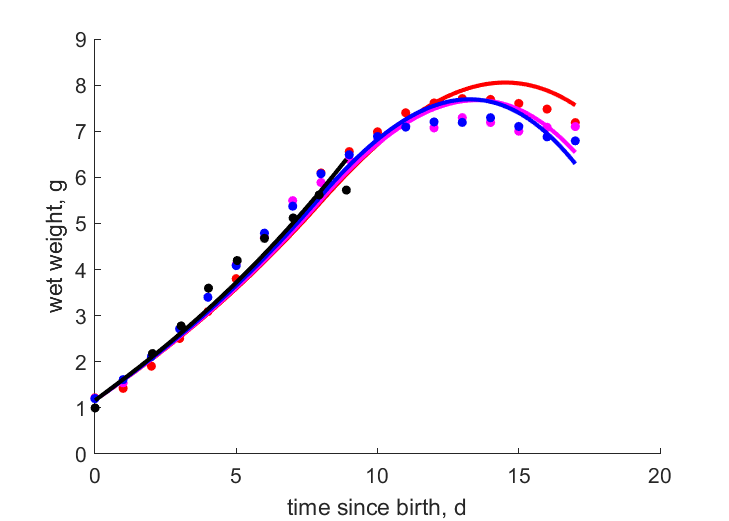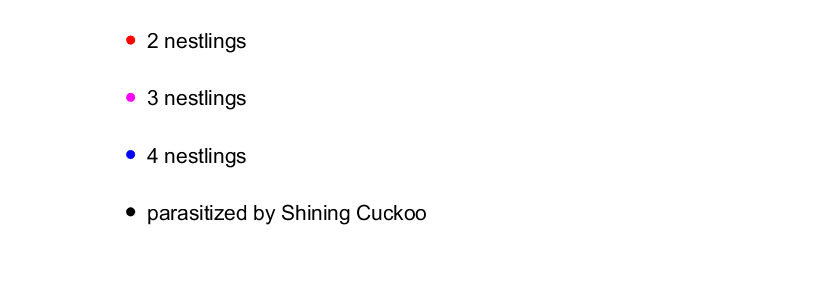Predictions & Data for this entry
| Model: std | climate: Cfb | migrate: | phylum: |
| COMPLETE = 2.7 | ecozone: TAz | food: biCi | class: |
| MRE = 0.041 | habitat: 0iTf, 0iTh | gender: Dg | order: |
| SMSE = 0.004 | embryo: Tnpf | reprod: O | family: |
Zero-variate data
| Data | Observed | Predicted | (RE) | Unit | Description | Reference |
|---|---|---|---|---|---|---|
| ab | 19.5 | 19.72 | (0.01135) | d | age at birth | Gill1982 |
| tx | 17.2 | 17.17 | (0.001483) | d | time since birth at fledging | Gill1982 |
| tp | 51.6 | 51.52 | (0.001636) | d | time since birth at puberty | guess |
| tR | 365 | 365 | ( 0) | d | time since birth at 1st brood | guess |
| am | 1789 | 1788 | (0.0005356) | d | life span | Gill1982 |
| V0 | 1.845 | 1.75 | (0.05172) | ml | Volume at start of development | Gill1982 |
| Ww0 | 1.49 | 1.75 | (0.1743) | g | egg wet weight | Gill1982 |
| Wwb | 1.18 | 1.159 | (0.0176) | g | wet weight at birth | Gill1982 |
| Wwi | 7.8 | 7.861 | (0.007885) | g | ultimate wet weight | Gill1982 |
| Ri | 0.02153 | 0.02148 | (0.002607) | #/d | maximum reprod rate | Wiki |
Uni- and bivariate data
| Data | Figure | Independent variable | Dependent variable | (RE) | Reference |
|---|---|---|---|---|---|
| tW |   | time since birth | wet weight | (0.05224) | Gill1982 |
| tW1 |   | time since birth | wet weight | (0.05682) | Gill1982 |
| tW2 |   | time since birth | wet weight | (0.05283) | Gill1982 |
| tW3 |   | time since birth | wet weight | (0.06984) | Gill1983 |
Pseudo-data at Tref = 20°C
| Data | Generalised animal | Gerygone igata | Unit | Description |
|---|---|---|---|---|
| v | 0.02 | 0.03622 | cm/d | energy conductance |
| p_M | 18 | 89.86 | J/d.cm^3 | vol-spec som maint |
| k_J | 0.002 | 0.003633 | 1/d | maturity maint rate coefficient |
| k | 0.3 | 0.2955 | - | maintenance ratio |
| kap | 0.8 | 0.8751 | - | allocation fraction to soma |
| kap_G | 0.8 | 0.8013 | - | growth efficiency |
| kap_R | 0.95 | 0.95 | - | reproduction efficiency |
Discussion
- Body temperature is guessed, and lower just after hatch
- mod_1: The same guess for body temperature is used throughout the data
- mod_1: Change ab from 17 to 19.5, which is the average value given in Gill1982
- mod_1: Change tx from 17 to 12.2, which is the average value given in Gill1982
- mod_1: Change am from 3285 to 4.9*365, as reported Gill1982
- mod_1: Add data for L0 and Li (Gill1982), but these are ignored because of inconsistency with weights
- mod_1: Add data for V0, Ww0, and Wwx from Gill1982
- mod_1: Change Wwb from 1 to 1.18, which is the average value given in Gill1982
- mod_1: Change Wwi from 6.5 to 6.45, which is the average value given in Gill1982
- mod_1: Change Ri from 0.0137 to (3.93*2)/365, which is the average value given in Gill1982
- mod_1: Update tW data according to values given in Gill1982 and adjust the functional response according to the brood size.The previous data was only from Gill1983, which refered to the growth of a nestling Grey Warbler sharing a nest with a Shining Cuckoo that shared a nest.The data from Gill1983 (now tW3) shows the effect of interspecific competition for food before the parasite evicts the host nestling.This parasitic competition data seems to follow the same trend as the growth data for a brood of four nestlings (tW2) in Gill1982;hence the same value for the functional response is assumed.Gill1982 reports that the weight of nestlings from broods of two is significantly heavier than those from broods of three and four,thus a higher functional response is assumed for the tW data.However, broods of three and four do not differ among themselves; hence a similar functional response value is assumed for both data (tW1 and tw2)
- mod_1: Update weights to improve fit
- mod_1: Add reference entries (Gill1982 and AttiThie2018) and facts
- Curator: In view of max weight larger than that at fledging, body temp is assumed to be constant, but food intake reduced prior to fledging
- mod_2: Puberty is assumed to coincide with fledging with a waiting time to first brood
Facts
- In New Zealand, the Grey Warbler, G. igata is the only host for a local subspecies of the Shining Bronze-cuckoo, Chalcites lucidus layardi. (Ref: Gill1982, Gill1983)
- Grey Warblers raise two broods per year, during a breeding season that lasts six months long (from first nest building to last fledging).First clutches of the host escaped parasitism because they were laid before most Bronze-cuckoos arrivedParasitized clutches received one cuckoo egg which replaced a host’s egg (Ref: Gill1982, Gill1983)
- In New Caledonia, the Shining Bronze-cuckoo parasitizes the related Fan-tailed Gerygone, G. flavolateralis (Ref: AttiThie2018)
Bibliography